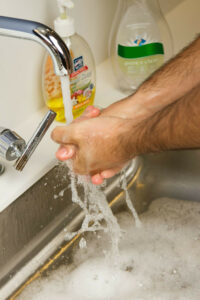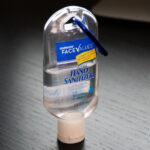Why provide hand sanitizing stations in your business?
1) when deploying hand sanitizers, location is everything
Here are the top three considerations to remember when placing hand sanitizers around your facility: location, location, location. If sanitizing stations are visible and easy to use, then people will use them. If they're in a corner or on a wall somewhere, they won't.
A hospital study in 2015 investigated whether compliance with hand sanitizing protocol is affected by the ease of use of sanitizers. Hand sanitizing was required in the hospital but staff did not always follow the policy.
The study found that location is crucial - if hand sanitizers are easy to find, then they're much more likely to be used.
Place hand sanitizers near entries and exits, make them easily visible, and advertise them.
2) Putting marketing or promotional messages on your hand sanitizer can strongly affect customers' purchase decisions
First impressions are lasting.  Said one senior executive at a major liquor company: “70% of customers’ choices are influenced as they walk through the door.”
Said one senior executive at a major liquor company: “70% of customers’ choices are influenced as they walk through the door.”
Ghost Tequila put a Hygio tower next to its end-cap display at a liquor store, and found that seasonally-adjusted sales of the brand went up by 35% vs. other similarly-priced tequilas. A hand sanitizer dispenser makes people stop, put away their phones, and pay attention to your message. What other branding location can promise that?
Hand sanitizers can do more than protect your health - they can promote your brand or send messages to your community.
3) Hand sanitizing prevents disease better than hand washing alone
 A common response to the proposal to purchase hand sanitizing stations is "we already have lots of places to wash hands - why do we need hand sanitizers?" While hand sanitizers don't replace hand washing, they're much more likely to be used and so are better at preventing disease. A Swiss hospital study found that even when people were required to wash their hands frequently and educated on the importance of doing so, they still didn't wash their hands frequently enough. Easy access to hand sanitizers improved hygiene and reduced infection.
A common response to the proposal to purchase hand sanitizing stations is "we already have lots of places to wash hands - why do we need hand sanitizers?" While hand sanitizers don't replace hand washing, they're much more likely to be used and so are better at preventing disease. A Swiss hospital study found that even when people were required to wash their hands frequently and educated on the importance of doing so, they still didn't wash their hands frequently enough. Easy access to hand sanitizers improved hygiene and reduced infection.
A quote from the study: "Alcohol-based hand rubs may be better than traditional handwashing as they require less time, act faster, are less irritating, and contribute to sustained improvement in compliance associated with decreased infection rates."
Hand sanitizing is not a replacement for hand washing; both together are much more effective than either alone.
4) Hand sanitizing makes masks more effective
 While masks help prevent the spread of disease from one person to another, wearing a mask alone doesn't do much to protect the wearer. People wearing masks tend to touch their faces more often and can actually increase the likelihood of catching a flu or virus.
While masks help prevent the spread of disease from one person to another, wearing a mask alone doesn't do much to protect the wearer. People wearing masks tend to touch their faces more often and can actually increase the likelihood of catching a flu or virus.
A study of 1178 young adults living in 37 residence houses in 5 university residence halls during the influenza season proved this. The students were randomly put into three different groups: the first group wore face masks and practiced regular hand sanitizing; the second group only wore face masks, and the third group did neither.
The differences between the three groups were striking. The group that wore face masks and practiced regular hand sanitizing had 75% less illness than the control group. The group that wore face masks alone saw almost no benefit - they got sick almost as much as the control group.
Masks and hand sanitizing together are much more effective than either alone.
5) Liquids work better than foams
 Should you use liquid (or gel) in your hand sanitizer or foam? Surprisingly, foams don't work as well as liquids. The research is clear: gels work better, period.
Should you use liquid (or gel) in your hand sanitizer or foam? Surprisingly, foams don't work as well as liquids. The research is clear: gels work better, period.
Wherever possible, use a liquid or gel for hand sanitizing, not a foam.
6) alcohol-based sanitizers work better than non-alcohol sanitizers
While sometimes a non-alcohol-based sanitizer is necessary, use an alcohol-based product wherever possible. They're more effective and (usually) cheaper.
Wherever possible, use an alcohol-based liquid or gel for hand sanitizing.
7) When making a business case, use this fact: hand sanitizing reduces absenteeism by 10-20%
 Justifying the expense of a full network of hand sanitizers can be difficult. One way to do this is to look at the costs of sickness and absenteeism. A rigorous study of 18 school districts compared matched pairs of schools, with experimental and control groups. In the experimental groups, hand sanitizing units were placed in classrooms, the cafeteria, administrative offices, and nurses' offices.
Justifying the expense of a full network of hand sanitizers can be difficult. One way to do this is to look at the costs of sickness and absenteeism. A rigorous study of 18 school districts compared matched pairs of schools, with experimental and control groups. In the experimental groups, hand sanitizing units were placed in classrooms, the cafeteria, administrative offices, and nurses' offices.
Students were told to use their normal hand washing practices, but use the sanitizer when entering and leaving the classroom - especially first thing in the morning, before and after lunch, recess, bathroom, before going home, and after a cough or sneeze.
Result: student absenteeism was reduced by 19.8% and teacher absenteeism declined 10.1%.
Adding hand sanitizing to hand washing dramatically improves health and reduces absenteeism
Source (1): Cure L, Van Enk R. Effect of hand sanitizer location on hand hygiene compliance. AJIC: American Journal of Infection Control. 2015;43(9):917-921. doi:10.1016/j.ajic.2015.05.013
Source (2): Interview with VP Marketing and Communications, Bacardi Spirits
Source (3): Pittet D. Improving Adherence to Hand Hygiene Practice: A Multidisciplinary Approach. Emerg Infect Dis. 2001;7(2):234-240. https://dx.doi.org/10.3201/eid0702.700234
Source (4): Aiello, A. E., Perez, V., Coulborn, R. M., Davis, B. M., Uddin, M., & Monto, A. S. (2012). Facemasks, hand hygiene, and influenza among young adults: a randomized intervention trial. PloS one, 7(1), e29744. https://doi.org/10.1371/journal.pone.0029744
Source (5): Leung, C. (2016). Comparing the effectiveness between gel and foam hand sanitizers. Bcit Environmental Health Journal.
Source (6): Leung, C. (2016). Comparing the effectiveness between gel and foam hand sanitizers. Bcit Environmental Health Journal.
Source (7): Hammond, B., Ali, Y., Fendler, E., Dolan, M., & Donovan, S. (2002, May 25). Effect of hand sanitizer use on elementary school absenteeism. Retrieved July 27, 2020, from https://www.sciencedirect.com/science/article/pii/S0196655300840109
